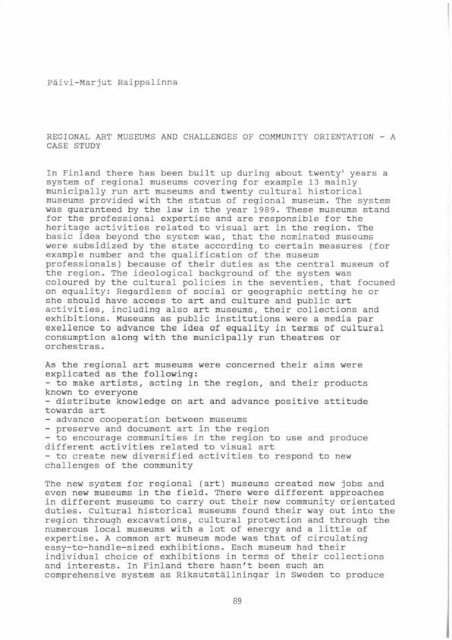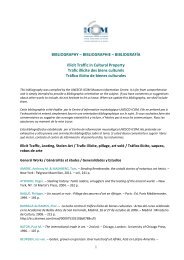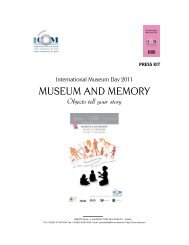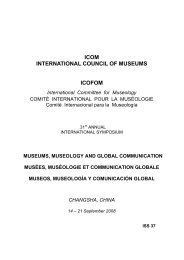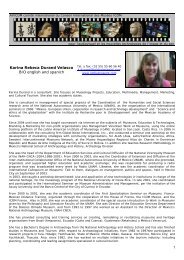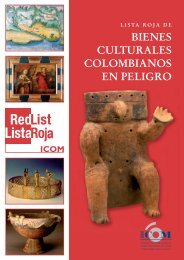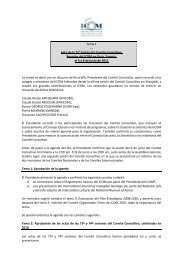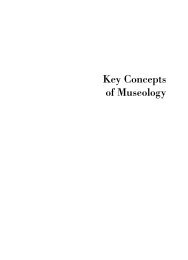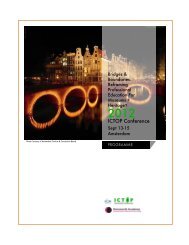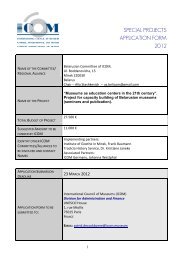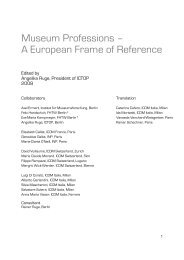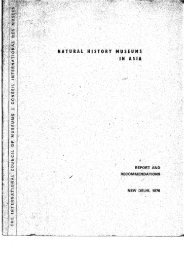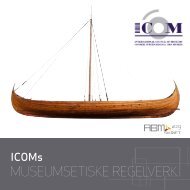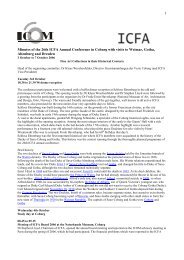ISS 25 (1995).pdf - The International Council of Museums
ISS 25 (1995).pdf - The International Council of Museums
ISS 25 (1995).pdf - The International Council of Museums
Create successful ePaper yourself
Turn your PDF publications into a flip-book with our unique Google optimized e-Paper software.
Paivi-Marjut Raippalinna<br />
REGIONAL ART MUSEUMS AND CHALLENGES OF COMMUNITY ORIENTATION - A<br />
CASE STUDY<br />
In Finland there has been built up during about twenty' years a<br />
system <strong>of</strong> regional museums covering for example 13 mainly<br />
municipally run art museums and twenty cultural historical<br />
museums provided with the status <strong>of</strong> regional museum. <strong>The</strong> system<br />
was guaranteed by the law in the year 1989. <strong>The</strong>se museums stand<br />
for the pr<strong>of</strong>essional expertise and are responsible for the<br />
heritage activities related to visual art in the region. <strong>The</strong><br />
basic idea beyond the system was, that the nominated museums<br />
were subsidized by the state according to certain measures (for<br />
example number and the qualification <strong>of</strong> the museum<br />
pr<strong>of</strong>essionals) because <strong>of</strong> their duties as the central museum <strong>of</strong><br />
the region. <strong>The</strong> ideological background <strong>of</strong> the system was<br />
coloured by the cultural policies in the seventies, that focused<br />
on equality: Regardless <strong>of</strong> social or geographic setting he or<br />
she should have access to art and culture and public art<br />
activities, including also art museums, their collections and<br />
exhibitions. <strong>Museums</strong> as public institutions were a media par<br />
exellence to advance the idea <strong>of</strong> equality in terms <strong>of</strong> cultural<br />
consumption along with the municipally run theatres or<br />
orchestras.<br />
As the regional art museums were concerned their aims were<br />
explicated as the following:<br />
- to make artists, acting in the region, and their products<br />
known to everyone<br />
- distribute knowledge on art and advance positive attitude<br />
towards art<br />
- advance cooperation between museums<br />
- preserve and document art in the region<br />
- to encourage communities in the region to use and produce<br />
different activities related to visual art<br />
- to create new diversified activities to respond to new<br />
challenges <strong>of</strong> the community<br />
<strong>The</strong> new system for regional (art) museums created new jobs and<br />
even new museums in the field. <strong>The</strong>re were different approaches<br />
in different museums to carry out their new community orientated<br />
duties. Cultural historical museums found their way out into the<br />
region through excavations, cultural protection and through the<br />
numerous local museums with a lot <strong>of</strong> energy and a little <strong>of</strong><br />
expertise. A common art museum mode was that <strong>of</strong> circulating<br />
easy-to-handle-sized exhibitions. Each museum had their<br />
individual choice <strong>of</strong> exhibitions in terms <strong>of</strong> their collections<br />
and interests . In Finland there hasn't been such an<br />
comprehensive system as Riksutstallningar in Sweden to produce<br />
89


